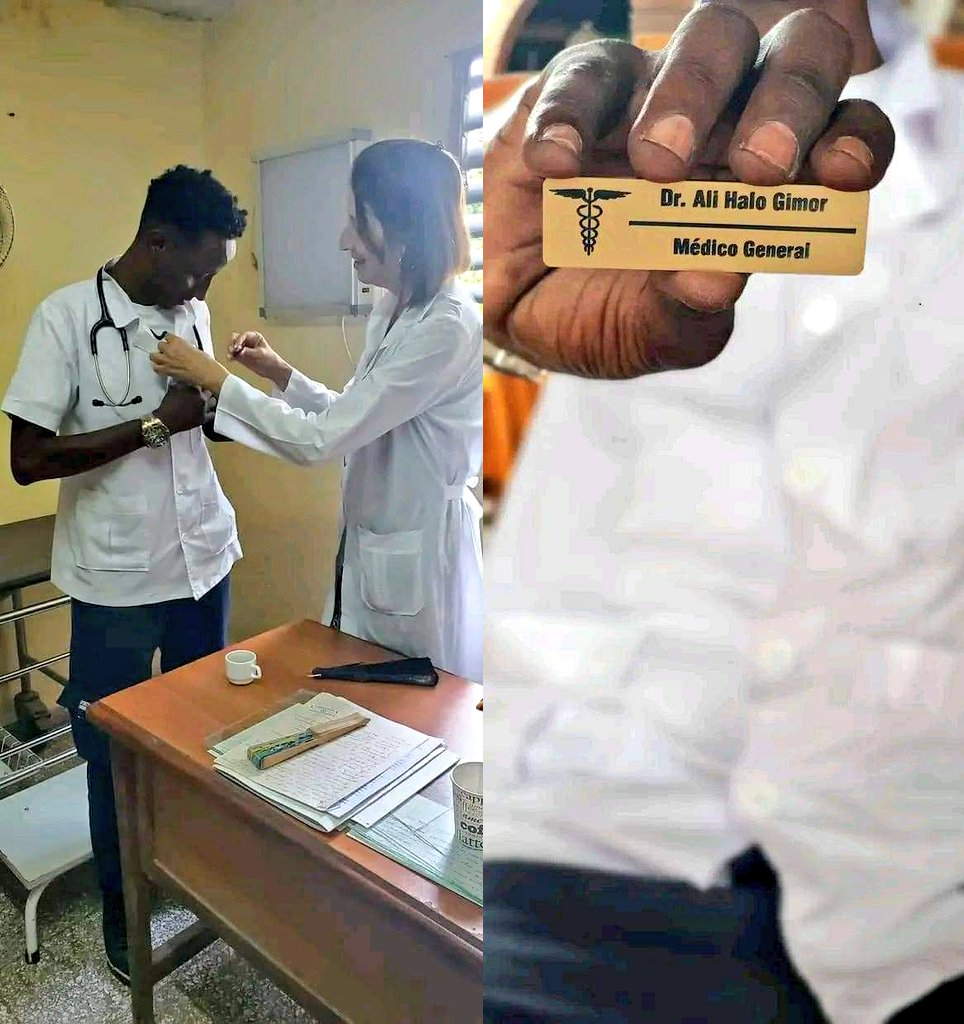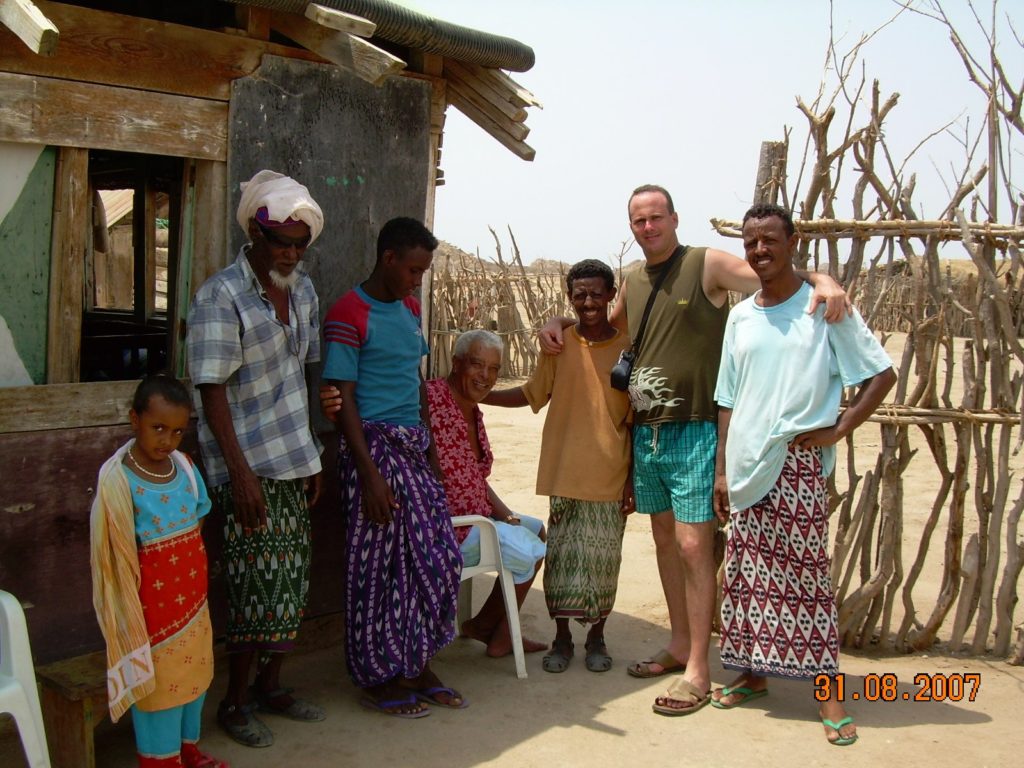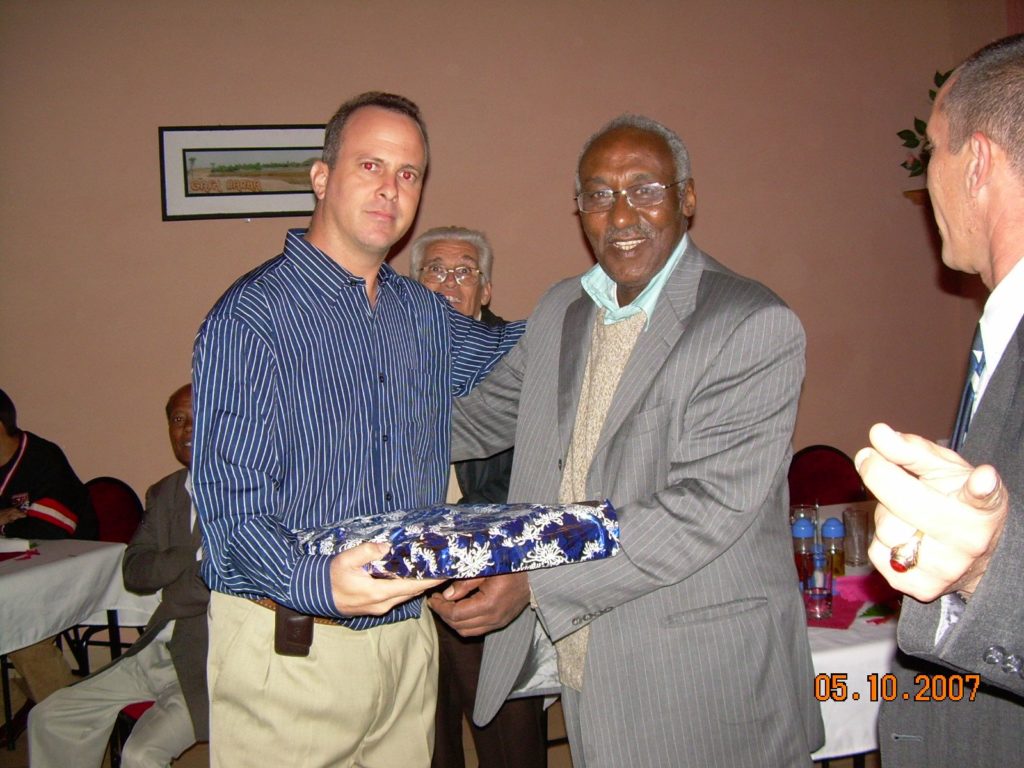The Cuban Revolution initially supported the Eritrean Revolution prior to the rise of the pseudo Marxist Derg regime who hijacked the Ethiopian Revolution. See more Here.
Despite the fact that Cuba switched sides to back the Derg regime before Eritrea’s liberation in 1991, the Eritrean elder revolutionary generation never viewed Cuba negatively. Instead, they have sought out solidarity and friendship with the Cubans. In fact, over 300 Eritrean medical students were trained by 67 Cuban doctors. As far as bilateral relations between Eritrea and Cuba are concerned, the two countries enjoy a warm relationship..Read more 1978 EPLF CAUTIOUSLY REJECTS RUMORS OF CUBAN FIGHTING IN ERITREA.

Cuba supports in growing Eritrean heartcare capabilities.


Despite his friendship and fond memory of his service to Eritrea he has constantly spoken out against the Cuban revolution and government and it must be noted.
Havana Journal of Medical Sciences
Online version ISSN 1729-519X
Rev haban cienc méd vol.11 no.3 Havana City July-Sept. 2012
EDUCATIONAL SCIENCES
The Orotta School of Medicine in Eritrea: another achievement of the Cuban collaboration
The Orotta School of medicine in Eritrea: another achievement of the cuban solidarity
Miguel Alfonso Álvarez Fornaris I , Estela Morales Peralta II
I Master of Science. First and Second Degree Specialist in Physiology. Assistant Professor. University of Medical Sciences of Havana. Faculty of Medical Sciences “Dr. Enrique Cabrera” fornaris@infomed.sld.cu
II Doctor of Medical Sciences. First and Second Degree Specialist in Clinical Genetics. Professor and Senior Researcher. University of Medical Sciences of Havana. National Center for Medical Genetics. peralta@infomed.sld.cu
SUMMARY
Introduction : Cuban solidarity has also manifested itself in the creation of medical schools in poor countries. One of them is Eritrea, where the Orotta School of Medicine (EMO) was created by Cuba in 2004.
Objective: to show results of the work carried out at the EMO. Material and methods : We reviewed the governing documents available in the EMO archives from its foundation until February 2012. The data obtained were analyzed according to objective criteria included in the Academic Classification of Universities. Results:
A curriculum inspired by the Cuban one of 2002 has been followed. The current enrollment is 204 males and 60 females, 93 students having completed the degree. The teaching results have been satisfactory, endorsed by two separate external exams for the first four courses, given by prestigious professors from accredited foreign universities and by WHO observers. 67 Cubans have given classes and trained Eritrean teachers, three of them PhDs in science and 15 masters, who have participated in the publication of 51 papers in indexed journals. Discussion:
Enrollment could be expanded and female enrollment increased, taking into account infrastructure, faculty, library and intranet conditions, as well as the country’s low medical coverage. The EMO must contribute to Eritrea in 2012 as many doctors as the existing ones to its foundation and although its quality is recognized and the work carried out great, it is necessary to continue improving it. Conclusions: the EMO constitutes another triumph of Cuban solidarity with the dispossessed of the world.
Keywords: medical teaching, Cuban solidarity, Eritrea.
ABSTRACT
Introduction: Cuban solidarity has also been present at the foundation of Medical Schools in poor countries like Eritrea, where the Orotta School of Medicine (OSM) was opened in 2004 with the help of Cuba . Objective: to show results of the work done in the OSM. Material and methods : the main available documents in the archives of the OSM were revised. Data were analyzed following Essential Science Indicators. Results:
the OSM follows a curriculum inspired in the Cuban one on 2002. The current registration figures are 204 males and 60 females, while 93 students have finished the career with outstanding results, certified by four external exams (EE) given by prestigious professors of two foreign accredited Universities to the first four batches, as well as by WHO observers. 67 Cuban professors have worked in the OSM both teaching undergraduate students and training Eritrean professionals, out of them three PhD and 15 Master degree holders who have published 51 papers in recognized medical journals. Discussion
: both the current registration figures and the female ratio could be broadened having into account the conditions of the staff, infrastructure, library and intranet, as well as the needs of health coverage of the country. By 2012 the OSM must supply Eritrea as many medical doctors as those available in 2004 and although the quality of the OSM graduates is recognized and outstanding work has been done, they need to be improved. Conclusions : the OSM is another achievement of the Cuban solidarity with the poor countries of the world.
Key words: medical education, Cuban solidarity, Eritrea.
INTRODUCTION
From its beginnings, the Cuban Revolution upheld the principle of human solidarity. 1 Our first brigade of International Medical Collaboration was sent to Algeria on May 23, 1963. 2 From then on, the number of countries to which assistance is provided increases every day, including the medical teaching area where inaugurated several medical schools abroad, preceded by the pioneer in Aden -Yemen-, in 1975, followed by those founded in Ethiopia and Guinea. At the same time, teachers have been sent to collaborate in various Educational Institutions in other countries. 1,3
Based on an Eritrean request, in 1998 our Commander in Chief offered help to open a school, and steps were taken to make this generous gesture of brotherhood a reality; which became official with the intergovernmental agreement in 2003. 4 In that year, above who would be the first dean, Dr. Mayra Más Juan del Pino, who began to organize the work with Eritrean experts. 5
On February 16, 2004, the Orotta School of Medicine (EMO), 4-6, was inaugurated in Asmara -capital of Eritrea- in order to train basic comprehensive doctors with community projection; whose knowledge, professional skills and practices in Medicine were in tune with scientific advances and satisfied the needs demanded by the health services of this brother Third World country. 6,7 This plan begins the comprehensive training of Eritrean doctors in their own territory.
The objective of this work is to show the results of the group that has made this project possible.
MATERIAL AND METHODS
The guiding documents available in the archives of the Orotta School of Medicine from its foundation until February 2012 were reviewed. These included the catalog, the records of the general secretariat, library and the person in charge of the Cuban teaching collaboration. The data obtained were analyzed according to objective criteria contained in the Academic Classification of Non-bibliometric and Bibliometric Universities, ESI (Essential Science Indicators). 8.9
Among the non-bibliometrics, the number of:
• Enrolled students.
• Graduated students in relation to those enrolled.
• Teachers with a scientific degree.
The objective bibliometric criteria analyzed were:
• Number of publications in refereed and indexed journals.
• Number of publications in high impact factor journals.
Additionally, the following criteria were included:
• Results obtained in the four external exams (EE) carried out in the period. These were:
o EE made by professors from Jezira University, Sudan, to the group or class of 2010, in October 2009.
o EE carried out by Swiss professors from the University of Geneva to students of the class of 2009, in November 2009, at the end of the internship.
o EE made in November 2010 by Sudanese professors from Jezira University to the class of 2011.
o EE given to the students of the class of 2012 in November 2011, by Sudanese professors from the University of Jezira.
All the EE carried out by Sudanese teachers were to students, who finished the fifth year, before starting the internship. The results of the 3 years were compared using the Analysis of Variance test with a significance level of 0.05.
The teacher pre-accreditation evaluation carried out by experts from the World Health Organization (WHO) in July 2010 was also consulted. 10
RESULTS
The study curriculum of the Orotta School of Medicine is based on the current Medicine Subjects program at the Cuban Medical Universities in 2002, adapted to the conditions of Eritrea; where the patient and the community are the focal points of instruction. 7.11
Table 1 shows the number of students enrolled by courses according to gender. The courses (classes) are named, according to the year in which their academic training culminates.
To date, two graduations corresponding to the 2009 and 2010 courses have been officially carried out at EMO, in accordance with regulations in force in the Republic of Eritrea. However, the class of 2011 has concluded its academic period, whose members have one year of social service left to achieve their official status as graduates.
Table 2 shows the number of students who have completed their academic training in relation to those initially enrolled.
The academic results have been generally satisfactory and the few casualties have occurred in almost all cases for non-teaching reasons.
When the EMO was inaugurated, it had six Cuban teachers, four Eritreans and two other teachers hired by the WHO. Progressively, Eritrean professionals have received preparation by our collaborators and have been assuming teaching functions 7,10 and strengthening the faculty with their own human resources, allowing the reduction of the Cuban presence. These results have been highlighted by the local press. 12-16
Table 3 includes the professionals who have provided teaching services at the Orotta School of Medicine since its creation and its scientific degree.
Table 4 shows the number of publications made by the Institution’s teachers that have appeared in refereed and indexed journals.
Of the 17 articles included in journals with international circulation, 12 appear in journals with a high impact factor. In addition to the publications mentioned by the teachers, we also add the authorship of four titles with ISBNs and the preparation of four complementary materials in English for teaching, which have been placed in the library.
In addition to what is summarized in Table 4, in the latest issue of the Journal of Eritrean Medical Association (JEMA. Volume V, Issue 1, September 2011) of a total of 11 articles, 9 were published by physicians belonging to the first group of graduates of the School, not included in Table 4. Cuban teachers have been authors of 36 publications on the site http://www.ilustrados.com . The conditions of the library, bibliography and intranet are considered satisfactory.
Table 5 shows the results obtained in the external exams, carried out by Sudanese professors in three groups or classes, in the five main disciplines of the degree (Internal Medicine, Pediatrics, Surgery, Community Medicine and Gynecology). The results of the EE for the first group (2009 class) are not comparable because other criteria were used.

No significant differences were found between the 3-year results (F= 0.325, NS)
DISCUSSION
Cuban medical collaboration abroad has been possible due to the effort made especially in the area of medical teaching, taking into account that in the first years of the Revolution, Cuba was left with just over three thousand doctors and 16 professors. 1 The high scientific level of Cuban Medicine is proven by the creation of Medical Schools for the training of health professionals in Cuba and in different countries 1 with graduates of a high professional level.
Table 1 shows an important gender difference with a male predominance and relatively low enrollment figures, according to the country’s needs, which could be increased given the infrastructure improvement and composition of the faculty. 10
Eritrea is one of the poorest countries in the world, located on the Red Sea coast of the African horn that was part of Ethiopia until 1993, with an estimated population of between 3 and 5 million and a subsistence economy. 10 It is estimated that in the Republic of Eritrea, before the creation of the EMO, there were 134 doctors, all graduated outside the country, which lacked a School of Medicine. Bearing in mind that up to the present moment, 93 doctors have completed their curricular studies corresponding to the Medicine career (as can be seen in Table 2 ).); its quantity has been increased by approximately 70%. At the end of the 2011-2012 academic year, the number of doctors in this African nation should rise to more than double the number that existed before the creation of this educational institution. These doctors have Primary Care as the fundamental axis of training and the main strategy to guarantee the health of the Eritrean people. 4-7 Its quality has been certified by four EEs and one WHO evaluation 10 , and is widely recognized by the population, authorities and foreign evaluators. 12-16
The number of publications in peer-reviewed and indexed journals of international circulation, which can be seen in Table 4 , demonstrates the scientific productivity of the mostly Cuban faculty and measures the ability of the teaching community to generate new knowledge, above all, taking into account that the EMO is a recently created institution with little permanence of the foreign faculty. Papers published in journals with a high impact factor are a sample of the knowledge generated among academic circles considered to be the most rigorous, and demonstrate the quality of the research, the results of which are published. However, a group of teachers still sends their work to non-refereed sites such as http://www.ilustrados.com. This evidently compromises the result of his own scientific effort, 17 a trend that shows a sustained and favorable decrease in recent years.
The results of the EE have been better and more stable in successive courses, without significant differences between them, which speaks in favor of the homogeneity of the students.
These results and the pre-professional and professional practices show the high quality of teaching, taught in English, which is not the mother tongue of Cuban teachers. This represents an additional effort and demonstrates the quality of the faculty. 12-16
From the internal and external evaluations as well as from the analysis of the documents 6,10 some recommendations emerge that show the need to:
-Continue increasing the objectivity of the teaching process and education at work, as well as evaluations.
-Continue to improve the infrastructure, which has been largely achieved with the move to a new facility, between May and August 2011.
-Regularize the process of categorization and promotion of teaching categories of the Eritrean faculty.
-Renew the study curriculum .
-Change the administrative structure to one that is in accordance with current regulations, the needs and possibilities of the country.
-Strengthen the structure and operation of teaching departments.
-Continue the process of institutionalization of the school.
– Make better use of the training capacity offered by Cuban teachers.
CONCLUSIONS
The EMO, founded by Cuban solidarity, has been established as a School of Medicine of recognized prestige, expressed by the quantity and quality of the graduates, as well as its faculty with high scientific productivity. This school constitutes another triumph of Cuban solidarity, helping the dispossessed of the world and must continue to improve its operation that allows it to maintain and exceed its results.
BIBLIOGRAPHIC REFERENCES
1. Marimon Torres N, Martinez Cruz IE. Evolution of the Cuban medical collaboration in 100 years of the Ministry of Public Health. Cuban Journal of Public Health. 2010; 36 (3) Online version ISSN 0864-3466.
2. MINREX. Cooperation of Cuba in the world. Document of the Vice Ministry of International Cooperation, MINREX, Havana, Cuba: January 15, 2009.
3. Rosell Puig W. Memories of that first trip [Internet site]. [cited 21 Jul 2005]. Available at: http://bvs.sld.cu/revistas/his/cua_88/cua0288.htm
4. Gebrehiwet M. Establishment of the Orotta School of Medicine: A vision at work. In: Orotta School of Medicine. First Commencement. Asmara: MBY Printing Press; Dec 5, 2009.
5. OSM characterization. Report requested by the MINSAP Postgraduate and International Relations Department. December 27, 2005.
6. Self Assessment Report for Orotta Schools of Medicine and Dental Medicine; June 2009.
7. Orotta School of Medicine: School Catalog 2004/05, Sabur Printing Services. Asmara. Eritrea: 2004.
8. Essential Science Indicators (ESI). February. 2012. URL available at: http://ranking.heeact.edu.tw/en-us/2010/TOP/100
9. Hirsch JE: An index to quantify an individual’s scientific research output. Proc Natl Acad Sci US A. 2005; 102(46):16569-72.
10. Chisi JE. Technical assistance for Regional Accreditation of the Orotta School of Medicine, Asmara, Eritrea. WHO Accreditation/WFME process. World Health Organization; July 2010.
11. Program of Medicine Subjects. Havana: Editorial Pueblo and Education; 1991.
12. Foreign experts laud the competence of students of Orotta School of Medicine [Editorial]. Eritrean Profile. Saturday, October 17, 2009. Page 1.
13. Issak T. First batch home grown doctors. Eritrean Profile. Wednesday, December 9, 2009. Pages 1, 3 and 4.
14. Major events in 2009: graduation of the first batch of Orotta School of Medicine [Editorial]. Eritrean Profile. Saturday, 2nd of January, 2010. Page 8.
15. Futsumbrham A. Orotta School of Medicine on its second commencement. Eritrean Profile. Saturday, December 10, 2011. Pages 2-3.
16. Gebrehiwet, K. The pursuit toward success bearing fruit. Eritrean Profile. Wednesday, January 4, 2012. Page 7.
17. Dorta Contreras AJ. In defense of our scientific production. ACIMED [Internet magazine]. 2006 Jun [cited 2012 Feb 29]; 14(3): Available at: http://scielo.sld.cu/scielo.php?script=sci_arttext&pid=S1024-94352006000300015&lng=es
Received: April 26, 2012.
Approved: May 20, 2012.